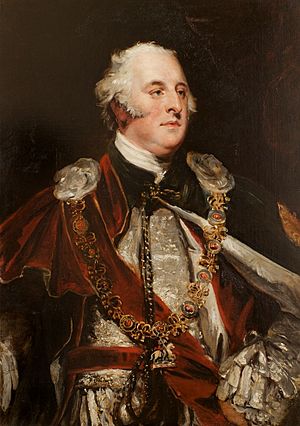John Pratt, 1st Marquess Camden facts for kids
Quick facts for kids
The Most Honourable
The Marquess Camden
|
|
|---|---|

Portrait by William Salter
|
|
| Lord Lieutenant of Ireland | |
| In office 13 March 1795 – 14 June 1798 |
|
| Monarch | George III |
| Prime Minister | William Pitt the Younger |
| Preceded by | The Earl Fitzwilliam |
| Succeeded by | The Marquess Cornwallis |
| Secretary of State for War and the Colonies |
|
| In office 14 May 1804 – 10 July 1805 |
|
| Monarch | George III |
| Prime Minister | William Pitt the Younger |
| Preceded by | Lord Hobart |
| Succeeded by | Viscount Castlereagh |
| Lord President of the Council | |
| In office 10 July 1805 – 19 February 1806 |
|
| Monarch | George III |
| Prime Minister | William Pitt the Younger |
| Preceded by | Viscount Sidmouth |
| Succeeded by | The Earl Fitzwilliam |
| In office 26 March 1807 – 8 April 1812 |
|
| Monarch | George III |
| Prime Minister | The Duke of Portland Spencer Perceval |
| Preceded by | Viscount Sidmouth |
| Succeeded by | Viscount Sidmouth |
| Member of Parliament for Bath |
|
| In office 1780–1794 |
|
| Preceded by | Sir John Sebright, Bt |
| Succeeded by | Sir Richard Arden |
| Personal details | |
| Born | 11 February 1759 Lincoln's Inn Fields, London |
| Died | October 8, 1840 (aged 81) Seale, Surrey |
| Nationality | British |
| Political party | Tory |
| Spouses | Frances Molesworth (d. 1829) |
| Alma mater | Trinity College, Cambridge |
John Jeffreys Pratt, 1st Marquess Camden (born 11 February 1759, died 8 October 1840) was an important British politician. He held several high-ranking jobs in the government. From 1795 to 1798, he was the Lord Lieutenant of Ireland. He also served as the Secretary of State for War and the Colonies from 1804 to 1805.
Contents
Early Life and Education
John Jeffreys Pratt was born in Lincoln's Inn Fields, London. He was the only son of Charles Pratt, a famous lawyer. His grandfather, Sir John Pratt, was a top judge in England.
When John was six years old, his father became a Baron. This meant John was then known as The Hon. John Pratt. He later went to Cambridge University, studying at Trinity College.
Political Career and Titles
John Pratt started his political career in 1780. He was elected as a Member of Parliament for Bath. In the same year, he got a well-paying job called Teller of the Exchequer. He kept this job for the rest of his life. After 1812, he even refused to take the large salary from it.
He worked in various government roles. From 1782 to 1783, he was a Lord of the Admiralty. He held this same position again from 1783 to 1789. He also served as a Lord of the Treasury from 1789 to 1792.
In 1786, his father received a new title, becoming an Earl. This meant John became known as Viscount Bayham. In 1793, he joined the Privy Council, a group of important advisors to the King.
A year later, in 1794, John inherited his father's title and became the 2nd Earl Camden.
Lord Lieutenant of Ireland
In 1795, Earl Camden was appointed Lord Lieutenant of Ireland. This was a very challenging time in Ireland. There was a lot of unrest, which led to the rebellion in 1798. After the rebellion was put down, he resigned from his position.
Later Government Roles
Earl Camden continued his political work. In 1804, he became the Secretary of State for War and the Colonies. This role involved managing military affairs and Britain's colonies.
The next year, in 1805, he became Lord President of the Council. He held this important position until 1806. He served as Lord President again from 1807 to 1812.
In 1812, he received even higher titles. He was made Earl of Brecknock and Marquess Camden.
Other Important Roles
Besides his government positions, Marquess Camden had other significant roles. He was the Lord Lieutenant of Kent from 1808 until his death in 1840. He also became the Chancellor of Cambridge University from 1834 to 1840.
He received high honors during his life. In 1799, he was made a Knight of the Garter. In 1802, he was elected a Fellow of the Society of Antiquaries of London.
Family Life
Lord Camden married Frances Molesworth in 1785. She passed away in July 1829. Lord Camden lived for another eleven years after her death.
He died on 8 October 1840, at the age of 81, in Seale, Surrey. His only son, George, inherited his titles.
The family owned a house at 22 Arlington Street in St. James's, London. This house was near the famous Ritz Hotel. In the year he died, Lord Camden sold the house.

